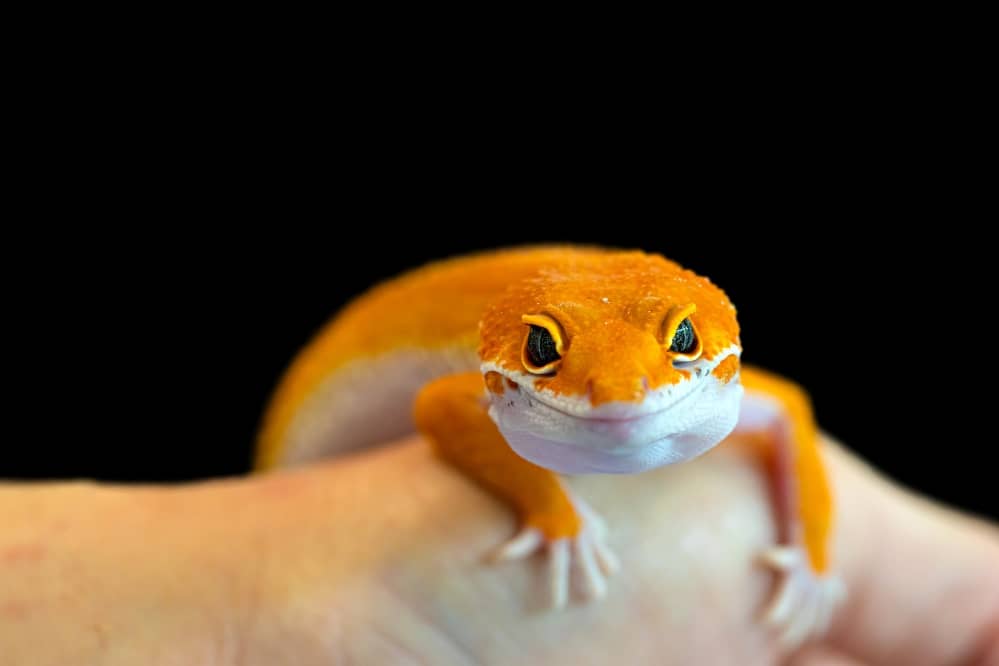One of the most fascinating aspects of leopard geckos is their distinct smile, which is also one of the reasons they are becoming popular pets, particularly among reptile lovers. But do leopard geckos genuinely smile?
In general, the smile of a leopard gecko is unintentional and does not express any of its feelings. Instead, a leopard gecko’s smile is merely a result of the anatomy of its face and a few other physical characteristics, such as movable eyelids.
This blog post is for you if you’re interested in learning about the science behind the smile of a leopard gecko and whether it conveys any emotions or not. In this post, we will give you a scientific explanation for leopard geckos’ smiles, so read on.
Do Leopard Geckos Really Smile?
Leopard geckos are reptiles with feelings and emotions, though they do not show them by smiling. Leopard geckos may appear to be smiling, however, it is a common misperception among leopard gecko owners. They only appear to be smiling because of the particular structure of their face and mouth.
Simply said, a leopard gecko’s facial anatomy is the science behind its smile. The following anatomical features give a leopard gecko the impression of smiling:
1. Jaw structure
Because leopard geckos are predatory reptiles, they have uniquely shaped jaws and lips that are not perfectly straight but slightly curved upwards.
The upward curvature of the mouth and lips allow leopard geckos to easily consume many types of insects, but it also gives them a smiling appearance.
Whether a leopard gecko’s mouth is open or closed, the shape of its lips never straightens out.
2. Head shape
The overall shape of a leopard gecko’s head is triangular and pointed. The triangular shape of the head adds to the curvature of the gecko’s lips, giving it a broader smile.
A leopard gecko’s smile is most noticeable when viewed directly from the front of its face due to the triangular shape of its head.
3. Cheek folds
Leopard geckos have extra skin that curls into acheek fold next to their upper lip, like dimples on a human cheek. These cheek folds are what give depth to their unique smile. When you look at the gecko from its side or directly from the front of its head, you can clearly see these cheek folds.
Though cheek folds may or may not be visible in some leopard geckos, they may be absent in others, such as day geckos. The primary purpose of these cheek folds is to facilitate the gecko’s ability to expand its mouth widely and ingest big insects.
These folds of additional skin provide extra flexibility to the jaws of the leopard geckos and add to their smiling impression.
4. Eye structure
The eye structure of the leopard geckos is also crucial in providing them with that iconic smiling look on their face. The unique feature of leopard geckos’ eyes is that they have movable eyelids, which greatly enhances the smiley appearance because the movement of the eyes plays a significant role in the expression of the smile.
When leopard geckos squint or partially close their eyes with the help of their movable eyelids it greatly adds to their smile. Though not all gecko species have flexible eyelids, such as crested geckos.
Do leopard geckos have a Duchenne smile?
Leopard geckos do indeed have a Dutchman smile, but what exactly is a Duchenne smile? The Duchenne smile is a term used to describe the true, pure expression of sheer happiness and is named after Guillaume Duchenne, an anatomist who first began to study smiles in detail.
The Duchenne smile is named because it appears as though a leopard gecko is smiling out of complete joy and happiness as it mostly squints or squeezes its eyes while making a smiley face.
Can Any Type Of Gecko Smile Other Than A Leopard Gecko?
The list of geckos that can make a smiley face, other than leopard geckos, is as follows. Because these geckos can move their eyelids, they are also known as “eyelid geckos.”
- Chinese cave gecko
- Hardwicke’s gecko
- Yucatán banded gecko
- African fat-tailed gecko
- Boettger’s strong-clawed gecko
- Cat gecko
Can Leopard Geckos Express Emotions Or Feelings?
Leopard geckos can express their emotions and feelings, but not with their trademark smile. Fear, excitement, and aggression are the main feelings associated with leopard geckos.
Your leopard gecko’s actions and body language will help you determine how it is feeling rather than its smile.
According to Dr. Hoppes of the Texas A&M College of Veterinary Medicine and Biomedical Sciences, leopard geckos can express feelings of delight when they are gently touched or offered food.
Is A Leopard Gecko Happy When It Is Smiling?
A leopard gecko’s smile does not indicate whether or not it is happy because it has nothing to do with how the gecko is feeling and is simply related to its facial anatomy.
In reality, when a gecko is happy, it won’t necessarily smile; instead, it will exhibit various behaviors like moving around the enclosure, seeming alert and active, approaching you when hungry, and responding to any movements.
Do Leopard Geckos Smile When They Are Sleeping?
Even when its eyes are closed, a leopard gecko may appear to be smiling. This is due to the leopard gecko’s curved lips and cheek folds, which continue to give the impression of a faint smile even when its eyes are closed or when it is asleep.
Do Baby Leopard Geckos Smile?
Since the baby leopard gecko’s facial anatomical features are nearly identical to those of an adult gecko, they could likewise appear to be smiling. Similar circumstances apply to juvenile leopard geckos.
Summary
Leopard geckos are intriguing creatures, and one feature that distinguishes them from the majority of other reptiles is their unique smile. A leopard gecko’s smile is entirely related to its facial anatomy and has nothing to do with the gecko’s emotions.
So never judge your leopard gecko’s state of mind based on its smile because it does not indicate feelings of happiness for them.

